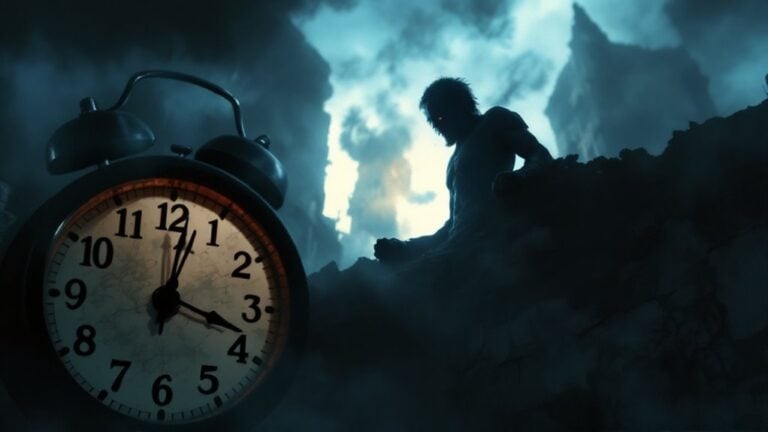Nolan’s Collaboration With Hans Zimmer in Interstellar
Nolan’s collaboration with Hans Zimmer in *Interstellar* transforms film scoring into an emotional journey, intricately interwoven with visual storytelling. Their partnership, rooted in successes since *Batman Begins*, evolved through innovative techniques like minimalism and unique instrumentation, which defined the film’s soundscape. Zimmer’s scores elucidate themes of love and sacrifice, particularly reflecting the father-daughter bond through poignant motifs. Critics laud the emotional depth and thematic complexity, highlighting how the music amplifies the film’s exploration of existence and time. This synergy not only enhances audience engagement but also leaves a lasting impact on cinematic experiences, illuminating deeper threads worth exploring further.
Table of Contents
Key Takeaways
- Nolan and Zimmer’s collaboration for *Interstellar* builds on their successful partnership since *Batman Begins*, evolving their artistic synergy.
- The scoring process began with a one-page story outline, ensuring the music aligned closely with the film’s narrative.
- Zimmer’s use of unique instruments and minimalist techniques redefined traditional scoring, creating a textural depth that enhances storytelling.
- The score emphasizes emotional connections, particularly the father-daughter relationship, through motifs and innovative compositional techniques.
- Critics praised the soundtrack for its complexity and emotional resonance, establishing a benchmark for future film music.
Origins of Their Collaboration
As their paths converged in 2005, Christopher Nolan and Hans Zimmer initiated a groundbreaking collaboration that began with Batman Begins.
This initial partnership set the stage for an artistic evolution, allowing both creators to explore new dimensions in filmmaking and scoring. Their work on sequels like The Dark Knight and The Dark Knight Rises showcased increasingly experimental and aggressive score designs, pushing the boundaries of traditional film music.
Zimmer’s unique soundscapes not only complemented Nolan’s visionary storytelling but also helped shape his artistic identity. The collaboration matured, ultimately influencing projects like Interstellar, where the emotional depth of Zimmer’s scores resonated with Nolan’s themes of family and time. Their partnership was significantly enhanced by the emotional core of the Interstellar theme, which reflects deep personal emotions related to parenthood. This emotional resonance is further amplified by the film’s exploration of the bond between parents and children, emphasizing how love can transcend time and space.
Together, they redefined cinematic scores, creating a legacy that continues to inspire.
The Compositional Process
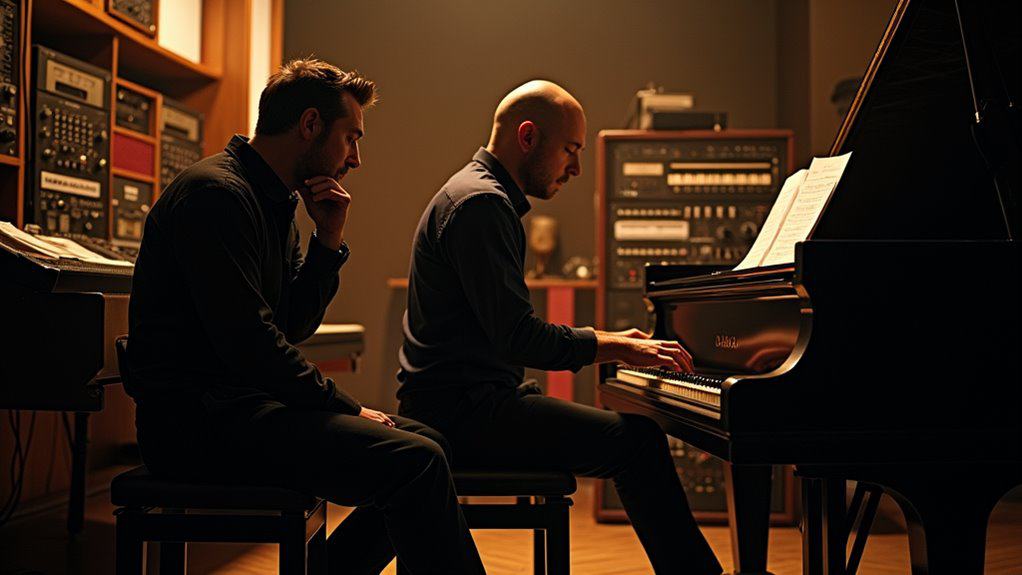
While commencing the compositional process for their projects, Christopher Nolan and Hans Zimmer established a unique and intimate approach that greatly shaped the film’s emotional landscape. Beginning with just a one-page story, Zimmer was tasked with creating a thematic foundation that would resonate throughout *Interstellar*. His initial four-minute piano and organ piece became the heart of the film, emphasizing love and connection. The collaboration involved parallel work between script writing and scoring, which allowed for a seamless integration of music and narrative. The score is characterized by thematic depth, which reflects the film’s exploration of complex emotions and human connections.
| Element | Description |
|---|---|
| Compositional Techniques | Use of varied instrumentation, including a Harrison & Harrison organ. |
| Thematic Development | Familial love theme intertwined with action motifs, creating emotional depth. |
| Recording Locations | Temple Church and AIR Lyndhurst Hall for unique acoustics. |
| Ensemble Composition | 34 strings, 24 woodwinds, a mixed choir of 60 voices. |
Through this collaborative effort, they produced a score that intricately linked emotions and narrative.
Emotional Themes in the Score

Emotion lies at the heart of *Interstellar*’s score, weaving a rich tapestry that captures the profound connections between characters amidst the vastness of space.
The emotional depth of Hans Zimmer’s musical motifs emphasizes human feelings, particularly the love shared between a father and daughter. Through repetition and light orchestration, the score evokes fragility, mirroring the delicate nature of human relationships in a cosmic setting. Zimmer’s collaboration with Nolan highlights the importance of early music development in shaping the film’s emotional landscape.
Techniques like pedal points and clock-like ticking enhance the urgency and intimacy of the narrative, while shifting chord progressions and arpeggios add layers of complexity. Notably, Zimmer’s use of a 1926 Harrison & Harrison organ reflects themes of fatherhood throughout the score.
Ultimately, the score not only complements the film’s imagery but also deepens the viewer’s emotional experience, making the connection between sound and emotion palpable throughout the journey.
Their Collaborative History

The powerful emotional themes in *Interstellar* stem from a long-standing collaboration between Christopher Nolan and Hans Zimmer, which began in 2005 with *Batman Begins*.
Their creative evolution showcases a remarkable collaborative synergy that has shaped modern cinema.
- Zimmer’s scores often influence the film’s narrative structure.
- Nolan involves Zimmer early in the development process.
- Their shared interest in themes of time manifests in their work.
- The unique composition process emphasizes a deep connection between score and screenplay. Live orchestration enhances the authenticity of Zimmer’s compositions, creating an even more impactful auditory experience. This collaboration also emphasizes the importance of music in film, as it enhances emotional impact and storytelling.
This partnership has consistently pushed boundaries, allowing Zimmer’s music to resonate profoundly within Nolan’s films.
Their dedication to intertwining sound and story transforms each project into an immersive experience, making their collaborative history a crucial component of contemporary filmmaking.
Critical Reception of the Score
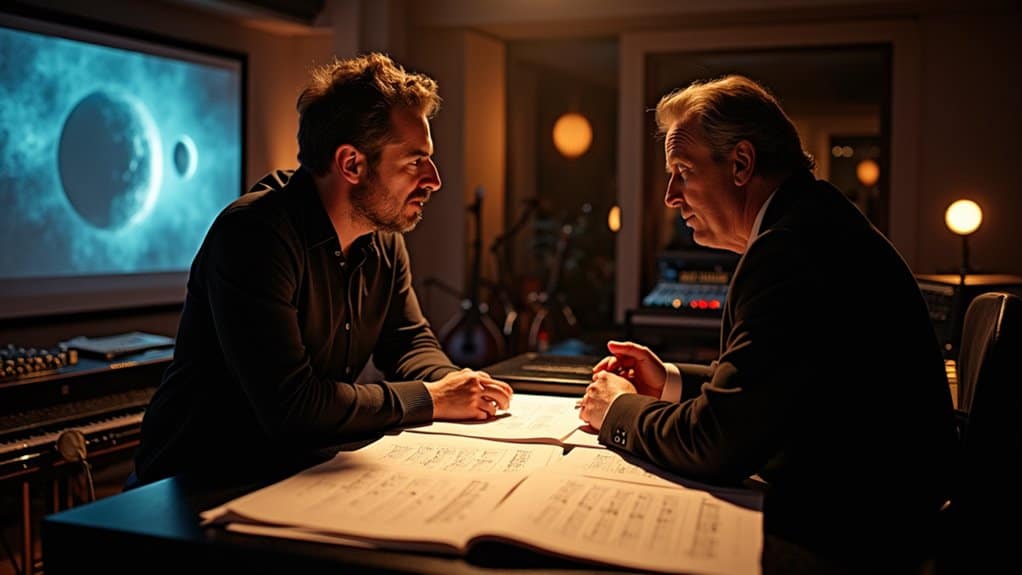
As critics have noted, Hans Zimmer’s score for *Interstellar* stands out for its thematic complexity and emotional depth, capturing both the vastness of space and the intimate struggles of humanity.
The score skillfully employs minimalistic musical techniques, using few notes and repetition to evoke the fragility of existence. Zimmer’s unique instrumentation, including the prominent organ and unconventional recording methods, creates a soundscape that resonates deeply.
Critics admire the score’s thematic exploration, seamlessly integrating with the film’s narrative and emphasizing its emotional core. The dynamic range—from soft, introspective passages to monumental crescendos—enhances the viewing experience, drawing audiences into the film’s emotional journey.
Lasting Legacy and Influence
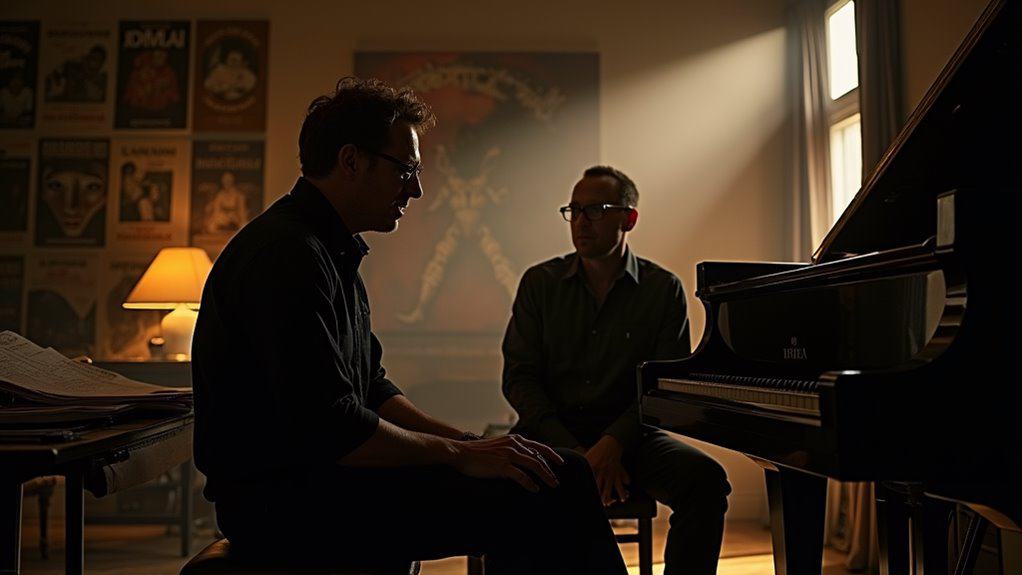
You can’t help but notice how the emotional themes in the Interstellar score resonate long after the film ends, capturing feelings of love, loss, and the vastness of space.
This collaboration between Nolan and Zimmer not only transformed what soundtracks could achieve but also set a benchmark for modern film music, influencing countless composers who followed.
As you explore the lasting legacy of their work, it becomes clear that their innovative approach has forever changed how audiences connect with cinematic storytelling.
Timeless Emotional Themes
Emotion resonates deeply in Hans Zimmer’s score for “Interstellar,” crafting a timeless connection that transcends the film itself.
By interweaving themes of love and parenthood, Zimmer creates a soundscape that reflects the emotional core of the story.
This score stands out for its:
- Profound musical motifs that link characters and events
- Use of the organ to signify the divine and the unknown
- Simple yet impactful harmonic structures that echo the passage of time
- A unique blend of action and familial love themes
The timeless resonance and emotional depth of Zimmer’s work not only enhance the storytelling but also leave a lasting legacy, influencing how film music explores universal human experiences long after the credits roll.
Impact on Modern Soundtracks
Zimmer’s groundbreaking work on “Interstellar” reshaped the landscape of modern soundtracks, setting a new benchmark for filmmakers and composers alike. His innovative approach to musical experimentation and soundtrack evolution created an emotional depth rarely seen in film. By incorporating unique instruments and a minimalist style, Zimmer crafted a score that resonates with audiences on a profound level.
| Element | Impact on Soundtrack Evolution | Emotional Resonance |
|---|---|---|
| Unique Instruments | Introduced new textures | Evokes a sense of wonder |
| Minimalist Approach | Redefined orchestration | Enhances emotional moments |
| Acoustic Resonance | Captured ethereal qualities | Connects with the divine |
| Collaborative Process | Fostered deeper storytelling | Amplifies character arcs |
| Universal Themes | Bridged diverse experiences | Reflects shared humanity |
This legacy continues to influence contemporary scores, inspiring future composers to explore new horizons.
Impact on Cinematic Experience
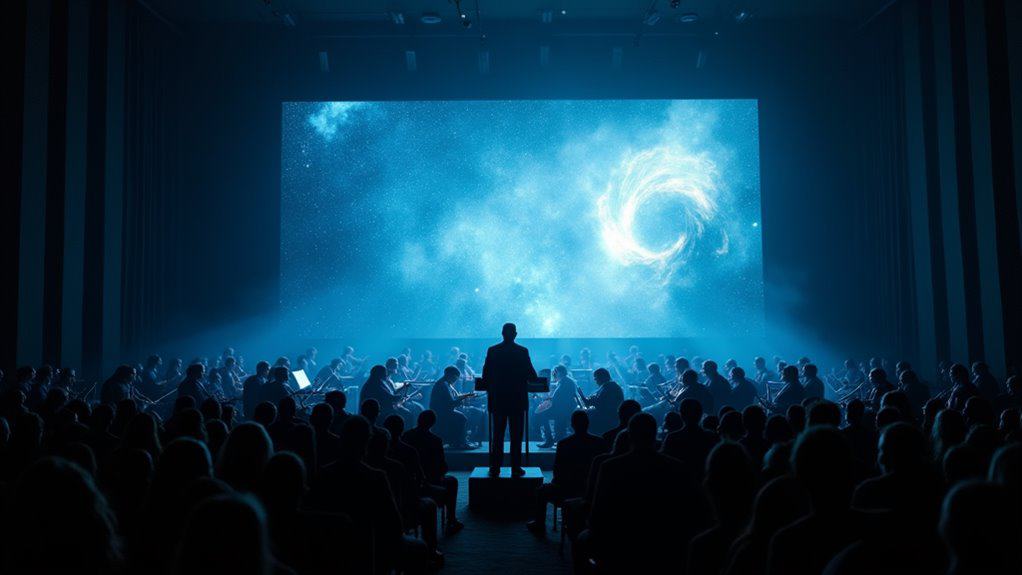
While the visuals in a film can captivate audiences, it’s the soundtrack that often deepens the emotional resonance of the story. In “Interstellar,” Hans Zimmer’s score serves as a crucial element of sound design, enhancing audience engagement through its profound emotional depth.
- The music mirrors human fragility against the vastness of space.
- Minimalist themes emphasize the delicate nature of existence.
- Repetition and powerful organ swells evoke awe and introspection.
- The score enriches the film’s exploration of family and time.
Zimmer’s collaboration with Nolan creates a cohesive experience, allowing the audience to feel the weight of each moment.
This intricate relationship between sound and storytelling elevates the cinematic experience, making it unforgettable.
Conclusion
In the cosmic tapestry of “Interstellar,” Nolan and Zimmer weave together sound and vision, crafting an experience that transcends the ordinary. Their collaboration not only enhances the film’s emotional depth but also redefines how audiences perceive cinematic storytelling. The haunting score echoes through the vastness of space and time, inviting you to reflect on love, sacrifice, and the human spirit. Ultimately, their partnership has left an indelible mark on film music, illuminating the path for future creators.





